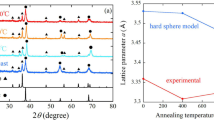Abstract
The anomalous magnetic and calorimetric properties atH c2, which we reported for a lead-indium sample, are in agreement with the prediction of a bulk first-order phase transition from recent theories for critical κ superconductors\(\kappa \approx 1/\sqrt 2 \). Other experimentalists, however, explain this behavior as an effect of the superconducting surface sheath. In an attempt to clarify the issue, magnetization and specific heat measurements are reported here on two samples with nominal concentrations of 1.9 and 1.4 at % indium in lead. The latter is type I above 6 K (T c =7.12 K). It is shown that surface effects are relevant for the effect reported previously. However, after empirical surface treatments have been applied to eliminate or at least minimize such effects, most of the results for the sample, which fulfills the theoretical requirements, are in agreement with theoretical predictions of Fischer, Usadel, and Jacobs. A bulk first-order transition atH c2 is thus, nevertheless, likely to occur for strong-coupling type II superconductors with critical κ values.
Similar content being viewed by others
References
R. Ehrat and L. Rinderer, inProc. 11th Int. Conf. Low Temp. Phys. (St-Andrews, Scotland, 1968).
R. Ehrat and L. Rinderer,Phys. Letters 29A(11), 712 (1969).
G. Fischer and K. D. Usadel,Solid State Commun. 9, 103 (1971).
A. E. Jacobs,Phys. Rev. Letters 26, 629 (1971).
A. E. Jacobs,Phys. Rev. B 4(9), 3022 (1971).
J. P. McEvoy and J. G. Park, inProc. 10th Int. Conf. Low Temp. Phys., Moscow (1966).
P. R. Doidge and A. R. Eastham,Solid State Commun. 9, 543 (1971).
J. P. McEvoy and J. Weber,Solid State Commun. 9, 1913 (1971).
R. Ehrat and L. Rinderer,J. Low Temp. Phys. 7(5/6), 533 (1972).
D. P. Jones and J. G. Park,Phys. Letters 20(2), 111 (1966).
H. Berndt, N. Kartascheff, and H. Wenzl,Z. Physik 24(6), 305 (1968).
B. J. C. Van der Hoeven, Jr. and P. H. Keesom,Phys. Rev. 137(1A), 103 (1965).
W. F. Druyvesteyn,Phys. Res. Rep. Suppl. 2, 30 (1966).
J. A. Cape and J. M. Zimmerman,Phys. Rev. 153(2), 416 (1967).
E. Eilenberger,Phys. Rev. 153(2), 584 (1967).
G. Fischer,Phys. Rev. Letters 20(6), 268 (1968).
M. C. Leung and A. E. Jacobs, inLow Temperature Physics LT-13 (Proc. 13th Int. Conf. Low Temp. Phys., Boulder, 1972) (Plenum, New York, 1974).
M. C. Leung,J. Low Temp. Phys. 12(1/2), 215 (1973).
J. Auer and H. Ullmaier,Phys. Rev. B 7(1), 136 (1973).
D. R. Aston, L. W. Dubeck, and F. Rothwarf,Phys. Rev. B 3(7), 2231 (1971).
Author information
Authors and Affiliations
Rights and permissions
About this article
Cite this article
Ehrat, R., Rinderer, L. The nature of the transition atH c2 in low-κ type II lead-indium superconducting alloys. J Low Temp Phys 17, 255–273 (1974). https://doi.org/10.1007/BF00659073
Received:
Issue Date:
DOI: https://doi.org/10.1007/BF00659073




